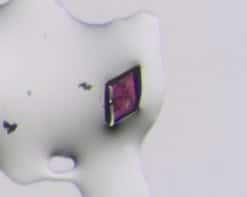
Gold nanotubes could be used along with near-infrared light (NIR) to destroy cancer cells, according to new experiments by researchers at the University of Leeds in the UK. The tubular nanoparticles could also be used as drug delivery vehicles and as nanoprobes for high-resolution medical imaging.
All living cells can be destroyed by heating them up. This can be particularly useful for killing cancer cells that are resistant to chemotherapy. Indeed, radiofrequency ablation and high-intensity focused ultrasound is routinely employed to heat and destroy tumours. Now, a team of researchers, led by Steve Evans of the School of Physics and Astronomy at Leeds, has found that gold nanotubes irradiated with NIR light can also be used to heat and destroy cancer cells.
Rapid heating
Evans and colleagues say that they have succeeded in controlling the lengths of the nanotubes, and were therefore able to produce nanostructures with the right dimensions to optimally absorb light in the NIR part of the electromagnetic spectrum. The light absorbed by the tubes heats them up, and by using a single-wavelength pulsed laser beam, the Leeds researchers were able to rapidly increase the temperature in the vicinity of the tubes so that it was high enough to destroy cancer cells. NIR light is ideal for this application because it penetrates several centimetres into tissue, and therefore many different types of tumours could be destroyed using this effect.
In addition, by adjusting the brightness of the laser pulse, Evans and colleagues say that they could use the nanotubes to either destroy cancer cells or to image tumours. For the imaging part, they made use of a new type of technique called multispectral optoacoustic tomography (MSOT) to detect the gold nanotubes in colorectal cancer cells in mice. In their experiments, the researchers intravenously injected the nanotubes into the animals and observed that the nanomaterials accumulated at the tumour sites. This is the first time that NIR-light-absorbing gold nanotubes have been used in a biomedical application, says the team.
Minimal toxicity
Because the nanotubes have a hollow central core, they can be loaded with anticancer drugs too, says team member James Mclaughlan from the School of Electronic and Electrical Engineering. “Combining targeting and localized release of therapeutic agents in this way could be used to identify and treat cancer with minimal toxicity to the patient.” Indeed, the researchers say that the mice excreted the gold nanotubes in around 72 hours, so they are therefore unlikely to be toxic to living organisms – an important point to consider when developing nanoparticles for biomedical applications. The fact that the tubes are coated with poly(sodium 4-styrenesulfonate) (PSS) also makes them less toxic to healthy cells while they are in the bloodstream.
Younan Xia of Georgia Tech in the US, who was not involved in this work, says that “although other types of gold structures including nanocages, nanorods and nanoshells have been used to destroy tumours before now, the new aspect in this work is the potential improvement in terms of tumour-targeting efficacy by altering the shape or morphology of the nanostructures”.
The research is reported in Advanced Functional Materials 10.1002/adfm.201404358.
- This article first appeared on nanotechweb.org



